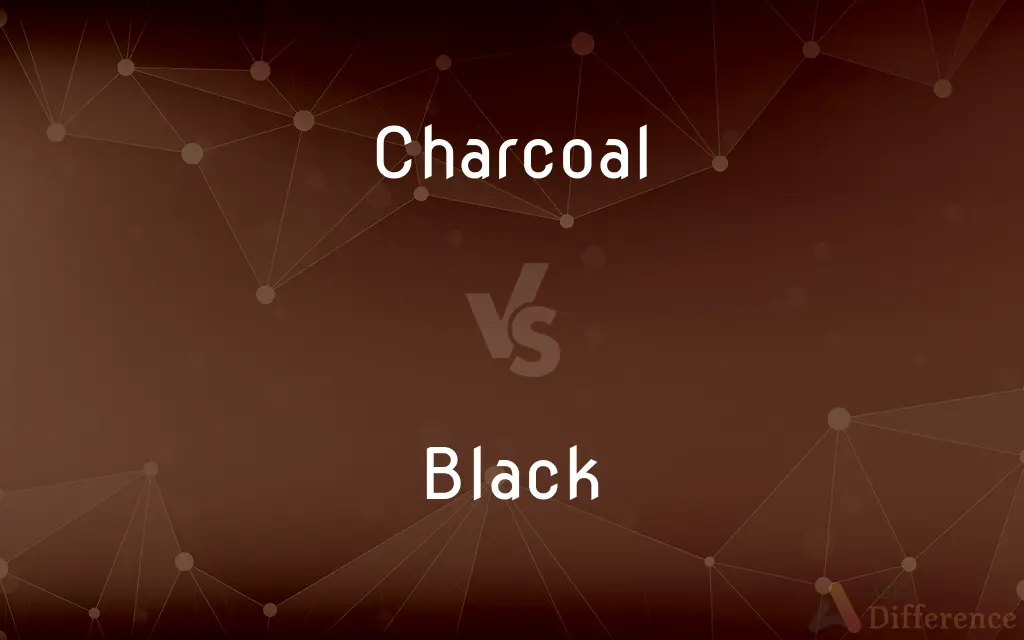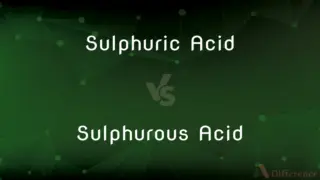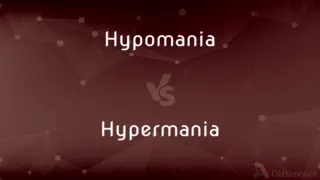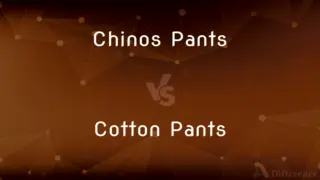Charcoal vs. Black — What's the Difference?
Edited by Tayyaba Rehman — By Maham Liaqat — Published on August 25, 2024
Charcoal is a dark grey color with hints of blue or green, often associated with the material used for drawing and fuel, while black is the darkest color, absorbing all light and symbolizing elegance or mystery.

Difference Between Charcoal and Black
Table of Contents
ADVERTISEMENT
Key Differences
Charcoal, as a color, takes its cue from the natural substance used in art and grilling, embodying a deep, dark grey that can carry subtle undertones of blue or green. This color is often used in design and fashion for its sophisticated yet softer alternative to pure black. On the other hand, black is the absolute darkest color, absorbing all wavelengths of light and representing the absence of color. It is a classic and versatile choice in various contexts, from fashion to art, known for its ability to convey power, elegance, or mystery.
In fashion and interior design, charcoal serves as a nuanced alternative to black, offering depth and warmth without the starkness or severity that black can sometimes bring. This makes it particularly appealing for those seeking a sophisticated, muted palette that still provides contrast and visual interest. Meanwhile, black remains a popular choice for its slimming effect, ability to match with almost anything, and its association with formality and chicness.
The usage of charcoal in art, particularly in sketching and drawing, highlights its ability to create rich shadows and depth without the harsh intensity of black. Artists value the subtle gradations that can be achieved with charcoal, allowing for a dynamic range of tones that enhance the texture and dimensionality of their work. Black, while also widely used in art, often serves as a bold statement or to provide extreme contrast, offering less nuance in shading compared to charcoal.
In terms of symbolism and psychological impact, charcoal conveys stability, subtlety, and strength, making it a favored choice in branding and marketing for businesses looking to project reliability without the severity of black. Black, however, is loaded with cultural and psychological associations ranging from sophistication and luxury to mourning and mystery, making it a powerful tool in visual communication to evoke specific emotions and reactions.
The preference for charcoal or black can also reflect personal or cultural attitudes towards color and aesthetics. Some may prefer charcoal for its softness and complexity, finding it less overwhelming than black in large amounts. Conversely, black's definitiveness and depth can be seen as providing clarity and simplicity, appealing to those who appreciate stark contrasts and minimalist design.
ADVERTISEMENT
Comparison Chart
Color Tone
Dark grey with blue or green undertones
Absolute darkest color, absence of light
Usage in Design
Offers a sophisticated, softer alternative
Used for elegance, formality, and contrast
Symbolism
Stability, subtlety, strength
Power, elegance, mystery, mourning
Preference
Favored for its nuanced and warm appearance
Preferred for its clarity and minimalist vibe
Artistic Use
Ideal for creating rich shadows and depth
Provides bold statements and extreme contrast
Psychological Impact
Conveys reliability without severity
Evokes a range of emotions from luxury to sadness
Fashion
Used for a sophisticated, muted palette
Known for its slimming effect and versatility
Interior Design
Creates depth and warmth
Offers stark contrast and timeless elegance
Cultural Associations
Associated with natural elements and artistry
Linked with formality, chicness, and luxury
Versatility
Provides contrast without overwhelming
Matches with almost anything, highly versatile
Compare with Definitions
Charcoal
A deep, dark grey color with subtle blue or green undertones.
The artist chose charcoal for the shadowing to add depth without harshness.
Black
The darkest color, absorbing all wavelengths of light.
The black dress was a classic choice for the formal event.
Charcoal
Preferred for its sophisticated and warm appearance in design.
The living room's charcoal walls created a cozy yet elegant ambiance.
Black
Symbolizes elegance, power, and mystery.
The designer used black to convey luxury and sophistication in the collection.
Charcoal
Represents stability and subtlety in color psychology.
The brand's charcoal logo conveyed reliability and professionalism.
Black
A versatile color in fashion, known for its slimming effect.
He preferred wearing black for its ability to match with any outfit.
Charcoal
Ideal for nuanced artistic work, allowing for rich gradations.
Using charcoal, the artist was able to achieve a dynamic range of tones.
Black
Used in art for bold statements and contrast.
The stark black background made the subject stand out dramatically.
Charcoal
Used to describe a color that mimics the hue of charcoal material.
The charcoal suit offered a softer alternative to traditional black.
Black
Represents clarity and simplicity in design.
The minimalist home featured black accents for a clean, modern look.
Charcoal
A black, porous, carbonaceous material, 85 to 98 percent carbon, produced by the destructive distillation of wood and used as a fuel, filter, and adsorbent.
Black
Being of the color black, producing or reflecting comparatively little light and having no predominant hue.
Charcoal
A very dark gray colour.
Black
Having little or no light
A black, moonless night.
Charcoal
Of a dark gray colour.
Black
The achromatic color value of minimum lightness or maximum darkness; the color of objects that absorb nearly all light of all visible wavelengths; one extreme of the neutral gray series, the opposite being white. Although strictly a response to zero stimulation of the retina, the perception of black appears to depend on contrast with surrounding color stimuli.
Charcoal
A very dark gray color
Black
The colour/color perceived in the absence of light, but also when no light is reflected, but rather absorbed.
Charcoal
Very dark gray
Black
That which is destitute of light or whiteness; the darkest color, or rather a destitution of all color; as, a cloth has a good black.
Black is the badge of hell,The hue of dungeons, and the suit of night.
Black
The quality or state of the achromatic color of least lightness (bearing the least resemblance to white)
Black
Being of the achromatic color of maximum darkness; having little or no hue owing to absorption of almost all incident light;
Black leather jackets
As black as coal
Rich black soil
Common Curiosities
Can charcoal and black be used together in design?
Yes, combining charcoal and black can add depth and complexity to a design, using charcoal for softer elements and black for stark contrasts.
How does the psychological impact of charcoal differ from black?
Charcoal conveys stability and subtlety, often seen as less severe than black, which can evoke stronger emotions such as power, elegance, or mourning.
Why is charcoal considered softer than black?
Charcoal has a muted, dark grey appearance with subtle undertones, making it less stark and more visually warm than pure black.
Why do artists use charcoal for drawing?
Artists use charcoal for its ability to create a wide range of tones, from light greys to deep blacks, allowing for rich depth and texture in their work.
What makes black a classic choice in fashion?
Black's versatility, elegance, and slimming effect make it a timeless choice in fashion, easily matching with any other color.
Why might someone choose charcoal over black for their brand?
A brand might choose charcoal for its logo or theme to project reliability and professionalism without the starkness or severity associated with black.
Is charcoal more versatile than black in interior design?
Charcoal can be seen as more versatile for creating warm, sophisticated spaces without the potential overwhelming effect of black, especially in large areas.
Is black more formal than charcoal?
Generally, black is associated with formality and elegance, making it a more traditional choice for formal occasions compared to the softer, more nuanced charcoal.
Can wearing charcoal have the same slimming effect as black?
While charcoal is slimming due to its dark tone, black is often considered the ultimate slimming color due to its ability to absorb light completely.
How do cultural associations of charcoal and black differ?
Cultural associations vary, but black is often linked with formality, luxury, and mourning, while charcoal is associated with natural elements, artistry, and a more subdued sophistication.
Share Your Discovery

Previous Comparison
Control Group vs. Experimental Group
Next Comparison
Cartilage vs. MeniscusAuthor Spotlight
Written by
Maham LiaqatEdited by
Tayyaba RehmanTayyaba Rehman is a distinguished writer, currently serving as a primary contributor to askdifference.com. As a researcher in semantics and etymology, Tayyaba's passion for the complexity of languages and their distinctions has found a perfect home on the platform. Tayyaba delves into the intricacies of language, distinguishing between commonly confused words and phrases, thereby providing clarity for readers worldwide.















































